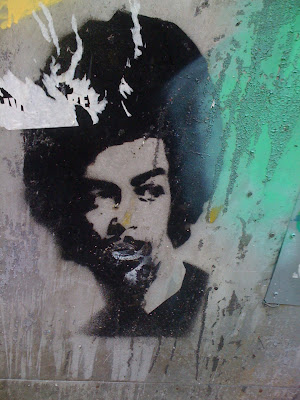 |
Gil Scott-Heron in Manhattan, 2012, from the cover
of his 1971 studio debut album Pieces of a Man. |
Walking down Lispenard Street a week or so ago, enjoying the perfect blue-sky, just crisp September Sunday, I caught
this portrait of Gil Scott-Heron. Wondered why the unknown artist who created the image chose
that spot to showcase the man who told us
the revolution will not be televised. The fact that the Arab Spring uprisings were not only
televised but thrown worldwide on the Internet notwithstanding (and to be fair, Scott-Heron was making a different point, and a fresh one in 1970 on his live debut album
Small Talk at 125th and Lenox), there was no
revolution, no uprising going on here in Tribeca yesterday. Just a steady stream of tourists buying knock-off designer purses and other goods and trinkets on Canal Street, a lot of sky-high real estate that the 99 percent can't afford, and aside from the denizens of Chinatown and the African street vendors on Broadway and Lispenard—a couple of whom proposed marriage or shopping, whichever—not a lot of ethnic diversity.
I snapped this shot of Scott-Heron and was just going to post the image and leave the story here at that, when my curiosity got the better of me. Why were the African vendors, whose goods were packed into rolling suitcases, all concentrated in that area? I typed in "Africans" along with the street name in the search engine and got no answer, but I did uncover something interesting: There
had been a revolution on Lispenard Street.
 |
| The only known image of David Ruggles (center) is this contemporary political cartoon, date unknown. |
In 1835 a young black activist named
David Ruggles founded, along with other African Americans, the New York Committee of Vigilance. The sole purpose of the society was to protect fugitives and confront slave catchers. Slavery had been completely abolished in New York by 1827, but the Fugitive Slave Law of 1793, signed by first U.S. president, George Washington, himself a slaveholder, stated that a "master" could enter any free state or territory and snatch back his "property." The official title was "An Act respecting fugitives from justice, and persons escaping from the service of their masters" Nowhere in the actual law does anyone admit to enslaving anyone. Our founding fathers wrote the law as if they had a natural right to enslave other human beings for life based on their African blood.
David Ruggles and his committee had the kind of courage I can only dream of. New York might have emancipated its black people, but there was no love for African-Americans. Many whites wanted to send them back to Africa, and the state constitution, adopted in 1821, disenfranchised most blacks from voting and participating in government. White laborers, encouraged by anti-abolitionist propaganda, rioted to keep blacks from taking all but the most low paying jobs. Any black person doing okay for him- or herself was deeply resented by poor whites.
Ruggles obtained lawyers for people who were "recaptured"—runaways fleeing slavery—and got the city to grant them trials. He helped some 600 fugitives, including a young Frederick Douglass, who later went on to be a powerful abolitionist.
 |
| Broadway and Canal, looking north c. 1835 by John Hill. Lispenard Street is one block southwest and out of the picture. |
Ruggles had a home and a bookstore at 36 and 67 Lispenard Street, respectively, the former being a refuge for runaways (there is a commemorative plaque there), the latter being set ablaze by arson in 1835. He was so feared and hated by southern slaveholders, his reputation having spread far and wide, that when a wealthy white northerner was in Savannah on business, and was mistakenly identified (by a drunk New York City marshal!) as an abolitionist who consorted with "David Ruggles, a damned nigger" (to quote the same New York marshal) he was nearly beaten by a mob. Ruggles didn't let any of this stop him—he moved his headquarters to Chapel Street, bought a printing press and distributed his paper
The Mirror of Liberty calling out slave catchers for the crime of kidnapping and demanding court dates and legal representation for fugitives. I think about my building on East 12th Street and living there, not knowing whether someone is going to try to burn it down or kill me in the street for my beliefs, and I can hardly imagine it.
When I stand on the corner of Lispenard and Broadway and think of people rioting in lower Manhattan, destroying black homes and businesses, and harassing, beating, and driving black people and their supporters out of the city, it's nearly impossible to visualize. But it makes sense to me now, the image of Gil Scott-Heron on the walls of the street where another revolutionary lived so long ago. Ruggles used his paper to fight slavery, Scott-Heron used another form of communication—spoken word—to fight racism and discrimination. For me Scott-Heron haunts Lispenard Street as a reminder of what used to be, what still is, and the work that must be done.





Comments